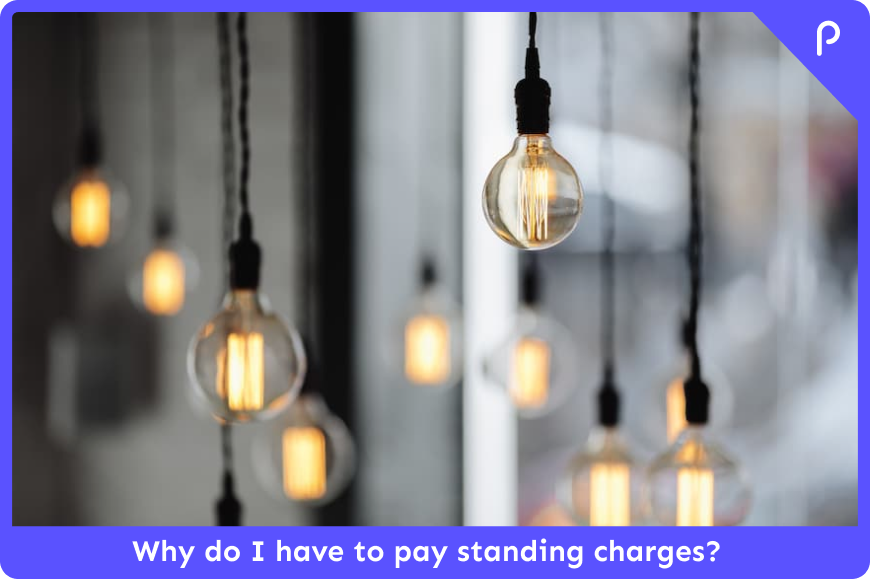Why do I have to pay standing charges on my energy bills?

Switch energy suppliers in minutes to save up to £400 a year!
Take control of your energy bills! Request a callback and let our experts guide you on how to save on your energy bills.
Free Service
When you look at your energy bill, you’ll see that one of the main costs, apart from your gas or electricity consumption, is the standing charge. Applied by almost all energy companies, the standing charge is a daily fee households are required to pay for their connection to the grid. The cost of a standing charge can vary widely. You could pay anywhere from 10p to 80p per day for your gas and 5p to 60p for your electricity connection. In most cases, the standing charge is payable every single day, whether you use any energy or not.
If you’re currently shopping around for a cheaper energy deal, comparing energy suppliers who offer standing charges may well have caught your attention. To help you understand exactly what this fee means, we’re taking a closer look at the standing charge and what it really costs.
Last update: November 2022
As you may have heard on the news, the UK energy market is currently under an immense amount of stress as a result of a global gas shortage driving up costs and putting several energy suppliers out of business. To learn more about this and stay updated on a daily basis you can read our page on the UK energy crisis.

Why do I pay a standing charge?
The standing charge that’s applied to your energy supply covers the costs your energy company incurs getting gas and electricity to your property. These costs include:
- Maintaining the energy infrastructure, including the wires and pipes that carry gas and electricity across the country to your home
- Keeping your home connected to the energy network
- Carrying out meter readings
- Environmental and social taxes
Do I have to pay a standing charge for electricity?
Virtually all energy companies apply a standing charge to both gas and electricity supplies. This means that, even if you get both your fuels from the same provider, you’ll have to pay a separate standing charge for each.
How much are standing charges?
Because standing charges are set by the energy companies themselves, they can vary significantly. On average, you can expect to pay between 10p and 80p per day for gas and between 5p and 60p for electricity.
In reality, most standing charges fall in the middle of these ranges. You’ll commonly see tariffs with standing charges of between 20p and 30p when looking for both gas and electricity.
How are standing charges calculated?
Standing charges are there to cover the fixed costs energy companies incur getting gas and electricity to your home. Energy companies set their own standing charges and it’s up to each supplier how much they charge.
When calculating standing charges, energy companies will look at the cost of maintaining local energy infrastructure, the amount they spend on staffing and running costs and the level of social and environmental taxes they’re subject to.
As the cost of maintaining energy infrastructure, paying staff and running a business can vary across the country, the amount you pay will depend partly on where you live.
Are there any plans without standing charges?
A lot of customers don’t like the idea of paying a standing charge for their energy. The standing charge can add a lot to your annual bill and, if you don’t use gas or electricity every day, it can seem like an unnecessary expense.
If you’d rather avoid this fee, you can now choose from a small selection of tariffs with a £0 standing charge. Currently, there are just two energy companies that offer tariffs without standing charges, these are:
What are cheap energy offers in the UK?
However, to make your life easier, we show you the three cheapest energy tariff. And the best is, that all of them are available at the moment.
| Supplier | Type | Name | Availability | Annual Cost | Green Tariff** |
|---|---|---|---|---|---|
| Dual Fuel | Double Gold | ✅ | 2,511.54* | ✖️ | |
 | Dual Fuel | Prepayment | ✅ | 2,581.02* | ✖️ |
 | Dual Fuel | Prepayment Variable | ✅ | 2,608.87* | ✖️ |
 | - | - | - | -* | - |
*Prices vary from one city to another, so we display national averages
*Based on 2,900.00 kWh of ⚡ and 12,000.00 kWh of 🔥 per year on average
**Is a Green tariff if all the energy consumed is compensated by renewable energy injections in the grid.
The cheapest energy tariffs in the UK.
The three overall cheapest energy offers can be seen down below. Although that doesn't mean, that they are all available in time of writing.
*Prices vary from one city to another, so we display national averages
*Based on Ofgem’s TDCV (2,900.00 kWh of ⚡ and 12,000.00 kWh of 🔥 per year).
**A tariff is green if for each kWh consumed a kWh of renewable energy is injected in the grid.
Should I switch to a tariff with no standing charges?
It can be very tempting to switch to a tariff without standing charges, however, it’s important to consider the pros and cons, and your personal circumstances, before you move supplier.
What are the advantages of a tariff with zero standing charges?
The main advantage of a tariff with zero standing charges is that you only pay for the energy you consume. This can make it simpler to keep track of your energy bills and help you to reduce your outgoings.
Zero standing charge tariffs are particularly well suited to holiday homes and properties that are empty for long periods of time. This is because standard tariffs will apply a standing charge every day of the year, whether the property is occupied or not.
If you only use your holiday home occasionally, you may well find it’s cheaper to select a tariff that doesn’t charge you for the days when no energy is used.


Want to switch energy suppliers? Switching with us has never been simpler.
Free Service
Let Papernest help you with your electricity and gas needs.
More info
What are the disadvantages of a tariff with zero standing charges?
The main disadvantage of tariffs with zero standing charges is that there’s less choice. With just two energy providers offering zero standing charges, you’re limited when it comes to picking a tariff. This means that the tariffs which are available may not be best suited to your needs.
To compare all available tariffs on the market, and find the option that’s right for you, call our Switch Plan and speak to a member of our expert team.
0330 818 6225
Why would I pay a standing charge if I don't have to?
As the vast majority of energy tariffs have a standing charge, you’ll have a lot more choice if you opt to pay the fee. In the long term, this can make your energy bills cheaper and save you money.
![]()

How can I compare energy tariffs?
When comparing energy tariffs, it’s important to take both the unit rate and standing charge into account. Both of these elements will contribute to the amount you pay, so finding the right balance is important if you’re going to select the tariff that’s perfect for your household.
Is it better to have a cheaper standing charge or unit rate?
In most cases, tariffs that have a high standing charge have a lower unit rate. Those with a lower standing charge tend to have a higher unit rate.
If your household uses a lot of energy, you may well find it’s cheaper to select a tariff with a high standing charge and low unit rate. A high consumption household is classed as one that uses around 17,000 kWh of gas per year or 8,000 kWh of electricity.
On the other hand, if you don’t use a lot of energy, a low standing charge with a high unit rate may suit you better. Low usage households are classed as those that use 8,000 kWh of gas or 2,500 kWh of electricity per year.
Looking to switch energy deals?Leave your phone number to request a call back from us!
Free Service
Do I have to pay standing charges on an empty property?
Unless you select a tariff with zero standing charges, you have to pay the fee every day, whether the property is occupied or not. If you own a property that’s empty for long periods of time, you may well find a tariff with no standing charges is a better option for you.
Would you like to know more about comparing energy bills? Great! Check out these related articles:
Looking to switch energy deals?Leave your phone number to request a call back from us!
Free Service
FAQ
Are there any plans without standing charges?
There are currently two suppliers in the UK offering tariffs with zero standing charges. These are Utilita and Ebico.
What is the average cost of a standing charge per day?
The average cost of a gas standing charge in the UK is 10p to 80p per day.
The average cost of an electricity standing charge in the UK is 5p to 60p.
What is the cheapest standing charge for electricity?
If you don’t want to pay this daily fee, you can opt for a tariff with zero standing charges. Alternatively, call our Switch Plan to find out which supplier has the cheapest standing charge in your area on 0330 818 6225.
Do I have to pay standing charges on an empty property?
Unless you select a tariff with zero standing charges, you have to pay the fee every day, whether the property is occupied or not. If you own a property that’s empty for long periods of time, you may well find a tariff with no standing charges is a better option for you.
Updated on 11 Nov, 2022
Alexander Striano
Energy Specialist & Copywriter
Alex joined the papernest team as a SEO Project Manager Assistant for Broadband Plans. He has developed a real expertise on connectivity topics and works on delivering the best possible content to help you navigate your broadband in and outside your home.
Alex joined the papernest team as a SEO Project Manager Assistant for Broadband Plans. He has developed a real expertise on connectivity topics and works on delivering the best possible content to help you navigate your broadband in and outside your home.
William Dautel
Website manager
William is a content marketing specialist. After 3 years writing brand strategies he joined papernest to help create the best content to help people handle and save on their utilities.
William is a content marketing specialist. After 3 years writing brand strategies he joined papernest to help create the best content to help people handle and save on their utilities.



